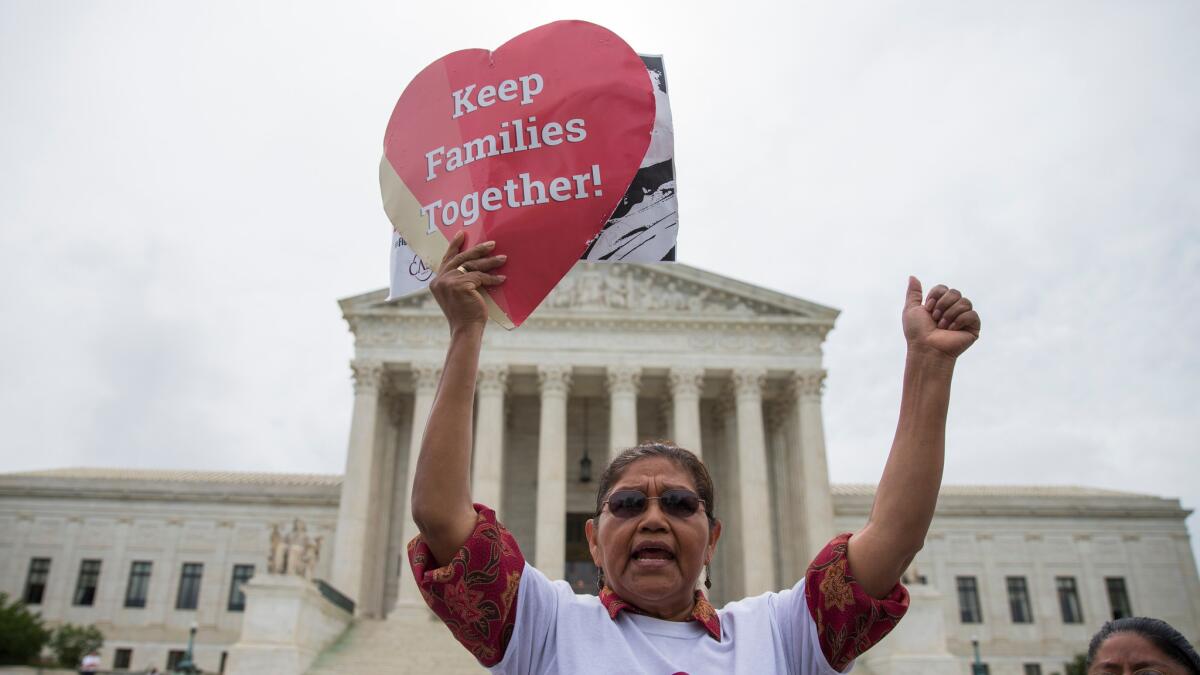Opinion: Court’s non-decision keeps millions of immigrants in limbo

The Supreme Court’s non-decision Thursday on President Obama’s deferred deportation program for more than 4 million people would be less frustrating if the judges had actually said something about it. But with the court deadlocked at 4-4, a decision that lets a lower court’s injunction stand, all it offered was the terse: “The judgment is affirmed by an equally divided Court.”
That means there is no published opinion, with or without dissents, that might shed some light on the court’s thinking on the core legal arguments over whether the president overstepped his executive authority in extending deferred deportations and a chance to apply for work permits to the parents of U.S. citizens and lawful permanent residents.
It seems pretty clear that the president has the power to do what he did. The courts have long given the executive latitude in exercising prosecutorial discretion — deciding which cases it should prioritize in enforcing laws. The states argued that Obama, rather than prioritizing deportations, created a new regulation and so should have followed the usual lengthy administrative review procedures. District Court Judge Andrew S. Hanen and a divided three-member appeals court panel agreed, but their reasoning is not persuasive.
So now the legal challenge by Texas and more than two dozen other Republican-led states goes back to Hanen’s court in Brownsville, Texas, for trial on the merits. How that will play out is anyone’s guess, but it’s troubling that Hanen’s decision in issuing the injunction — which seemed more rooted in politics than law — stands.
And with the clock running out on the Obama administration, the future is murky. A President Trump would put a spike in the program (or maybe bury it in the foundation of his border wall). A President Clinton would continue the legal fight and expand the Deferred Action for Parents of Americans and Lawful Permanent Residents.
The net effect, though, is yet more delay in the government making any headway in reforming immigration laws and policies, which have been broken for years. Republican politicians have railed about the issue, yet the House Republican leadership two years ago killed a bipartisan immigration reform bill that already had cleared the Senate.
So we muddle on, with some 11 million people deeply integrated into our communities and workplaces, but without legal permission to live here. Throwing them out, despite Trump’s reprehensible rhetoric, is not a solution. For beginners, many of the same people who urge that approach would choke at the cost — as much as $600 billion, according to one estimate — and the size of the government immigration force it would take to achieve it. And removing millions of workers from the economy would shave $1 trillion from the GDP (per this American Action Forum report).
With the clock running out on the Obama administration, the future is murky.
Obama is right to focus deportation proceedings on those who pose a public safety risk and those whose criminal pasts make them ineligible for legal residency. I’m less enamored with another priority — turning around recent arrivals — because the government all too often removes people without giving them sufficient time and resources to make the case that they have a legal right to stay (asylum-seekers, for instance).
Ultimately, Obama’s deferred action program would help many folks now living and working in the U.S. — the vast majority of whom have lived here for more than a decade — come out into the open and live their lives with a little less fear.
Follow my posts and re-tweets at @smartelle on Twitter
More to Read
A cure for the common opinion
Get thought-provoking perspectives with our weekly newsletter.
You may occasionally receive promotional content from the Los Angeles Times.







